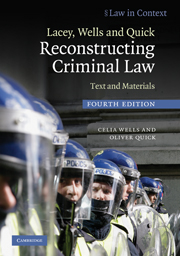Book contents
- Frontmatter
- Contents
- Preface
- Table of cases
- Table of statutes
- Section I Approaching Criminal Law
- Section II Law, Order and Security
- Section III Interpersonal Violence; Drugs and Alcohol Abuse; Offence Preparation and Participation
- Section IV Property and Propriety
- 11 Defining and Defending Private Property
- 12 Constructing Property in Criminal Law
- 13 Property Rights and Criminal Enforcement
- Section V Regulating Sexuality and Bodily autonomy
- Section VI Making a Killing
- Bibliography
- Index
- References
12 - Constructing Property in Criminal Law
from Section IV - Property and Propriety
Published online by Cambridge University Press: 05 June 2012
- Frontmatter
- Contents
- Preface
- Table of cases
- Table of statutes
- Section I Approaching Criminal Law
- Section II Law, Order and Security
- Section III Interpersonal Violence; Drugs and Alcohol Abuse; Offence Preparation and Participation
- Section IV Property and Propriety
- 11 Defining and Defending Private Property
- 12 Constructing Property in Criminal Law
- 13 Property Rights and Criminal Enforcement
- Section V Regulating Sexuality and Bodily autonomy
- Section VI Making a Killing
- Bibliography
- Index
- References
Summary
We now move to the legal context to consider how property interests and threats to property are constructed by criminal laws. Just as many ‘offences against the person’ have public order or property-affecting aspects, so many ‘property offences’ have public order or person-affecting repercussions. The relative seriousness of the offences enacted in the Theft Acts 1968 and 1978 and the Fraud Act 2006 – theft, handling stolen goods, burglary and aggravated burglary, robbery, taking a conveyance without authority, abstracting electricity, going equipped for stealing, blackmail, making off without payment and fraud – relate not only to the extent to which they threaten property rights but also to violations of trust and the threats to social order, authority and the person which they pose. Robbery and aggravated burglary attract maximum sentences of life imprisonment largely on the latter ground, and the fact that there is a higher maximum for handling than for theft is perhaps to be explained not just by the argument that thieves could not survive without handlers and thus that handling is an important focus for punishment and prevention (after all, the converse is equally true) but in terms of the idea that handling systematically supports the institution of theft in a way which potentially undermines the system of property entitlements more thoroughly than does theft.
In considering criminal law's construction of property offences, we should not, however, confine our view to the Theft Acts.
- Type
- Chapter
- Information
- Lacey, Wells and Quick Reconstructing Criminal LawText and Materials, pp. 372 - 448Publisher: Cambridge University PressPrint publication year: 2010

